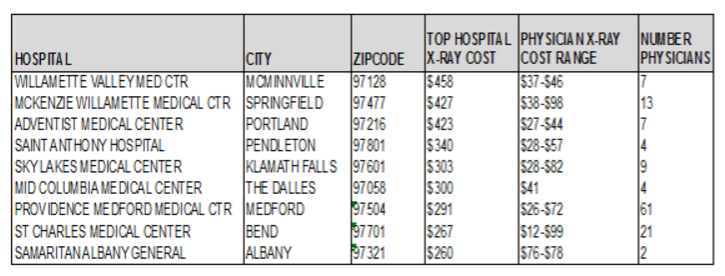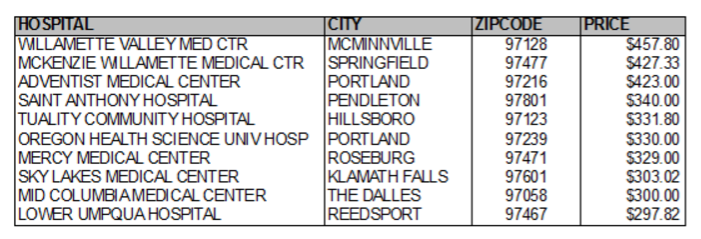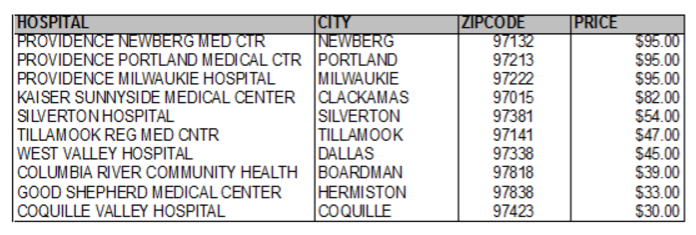Hospital Pricing Specialists recently completed a national study analyzing the costs of more than 18.7 million chest x-ray claims across the country, and found prices in hospitals were in many cases 3-10 times more expensive than those performed in physician office settings.
Out of 59 hospitals in Oregon, Willamette Valley Medical Center, a for-profit Level III Trauma Center in McMinnville, charged the highest cost to perform a chest x-ray at $457.80, or 10-12 more than a chest x-ray completed at a physician’s office in McMinnville (doctors costs ranged from $37 to $46 per x-ray).
To slice the detail by zip code, The Lund Report compared the highest cost x-ray performed at a hospital setting for each of the nine geocode regions in Oregon (from 970-978), with physician offices in the same zip code and found some very surprising results. The costs for hospital chest x-rays ranged from 3-22 times more expensive than those performed at physician offices within the same zip code.
The table below lists highest costs for chest x-rays performed at hospitals compared to physicians within the same zip code. The last two columns show the cost range of physician-performed chest x-rays and number of doctors performing the service within the comparative zip code.

The median cost for chest x-rays performed at Oregon hospitals was $247. About 40 hospitals (68 percent) charged more than $200 per chest x-ray completed. Of the remaining hospitals, seven charged between $164 to $191, and 12 charged less than $100 per chest ray.
McKenzie Willamette Medical Center in Eugene, also an investor-owned hospital, scored the second highest in the cost for a chest x-ray -- $427.33.
In October, 2003, it partnered with Triad Hospitals in a joint venture, and was reorganized from a non-profit organization to a for-profit limited liability company. Since then, Community Health Solutions, Inc., has purchased Triad Hospitals.
Here are the top 10 highest chest x-ray costs at Oregon’s hospitals.

Three Providence facilities – in Newberg, Portland and Milwaukie – had the lowest costs for chest x-rays, followed by Kaiser Sunnyside Medical Center and Silverton Hospital, which is being acquired by Legacy Health.
The table below shows the 10 hospitals at the lowest cost tier for chest x-rays performed in Oregon.

The median physician office cost for a chest x-ray in Oregon was $47. Out of 576 doctors performing chest x-rays, 57 percent charged less than $50 -- 40 percent charged between $51-$99 -- and the remaining 3 percent charged from $100-$318.
The lowest cost x-ray performed by physicians was in Bend, at $12 (with the bottom 10 cost tier of physician office chest x-rays all performed in Bend).
A Portland family nurse practitioner, Madeleine Sanford, charged the highest cost for a chest x-ray, $318, closely followed by two Portland physicians, Drs. Amanda Risser, $312.67 and Dr. Clifford Coleman, $301.86.
Here are the top 10 physicians charging the highest cost chest x-rays in Oregon.

“Hospital Pricing Specialists calculates the most recent prices by analyzing patient claims data obtained from government agencies, patient-submitted bills, internet research, and phone surveys, “ according to Rick Louie, Principal. The company, located in Silicon Valley provides hospital price benchmarking reports to hospitals, physician offices, ambulatory surgery centers, reference labs, and imaging centers.
“Hospital senior management use the reports to ensure their prices are in line with the local market,” Louie told The Lund Report.
Kathryn can be reached at [email protected].
Comments
Hospital X-Ray Costs
Is this the gross billed charge amount or allowed amount from the payer? As we all know in healthcare, if the provider is contracted with the payer, the billed amount is irrelevent.
Why would a payer have such high allowables for a procedure?
Scott Osburne
Hospital X-ray Costs
Dr. Waldmann is right. These comparisons are embarrassing for hospitals, but soon enough there will be no more X-rays done in independent doctors offices, because there won't be any independent doctors. It's the patients who get scalped in the end.
Dr Nick Benton
X-Ray Pricin
Katheryn and Diane--Thank you! Two words come to mind. "Single-Payer!."
This peak--a very slight pulling-back of the heavy, dark shroud of commercial secrecy in health care --is superb, and much-needed reporting! I hope you make further use of 'Hospital Pricing Specialists' work and other efforts to bring full transparency to pricing and profits in all areas of health care products and procedures-- including pharmaceuticals.
Dick Gold
Single payer
I don't necessarily oppose single payer as a model, but the above story is essentially due to single payer. For those 65 years and older, Medicare pays for the vast majority of health care as a single payer, and has chosen to pay hospitals more and physicians less. This rewards the less efficient, at the expense of the more efficient, which seems contrary to reducing cost. Additionally, private insurers seem to base their rates off of Medicare rates.
Dr. Mike Henderson
This price differential certainly helps to explain how hospitals can continue to buy up physician practices and pay significantly higher physician salaries than physician owned practices.
Dr George Waldmann